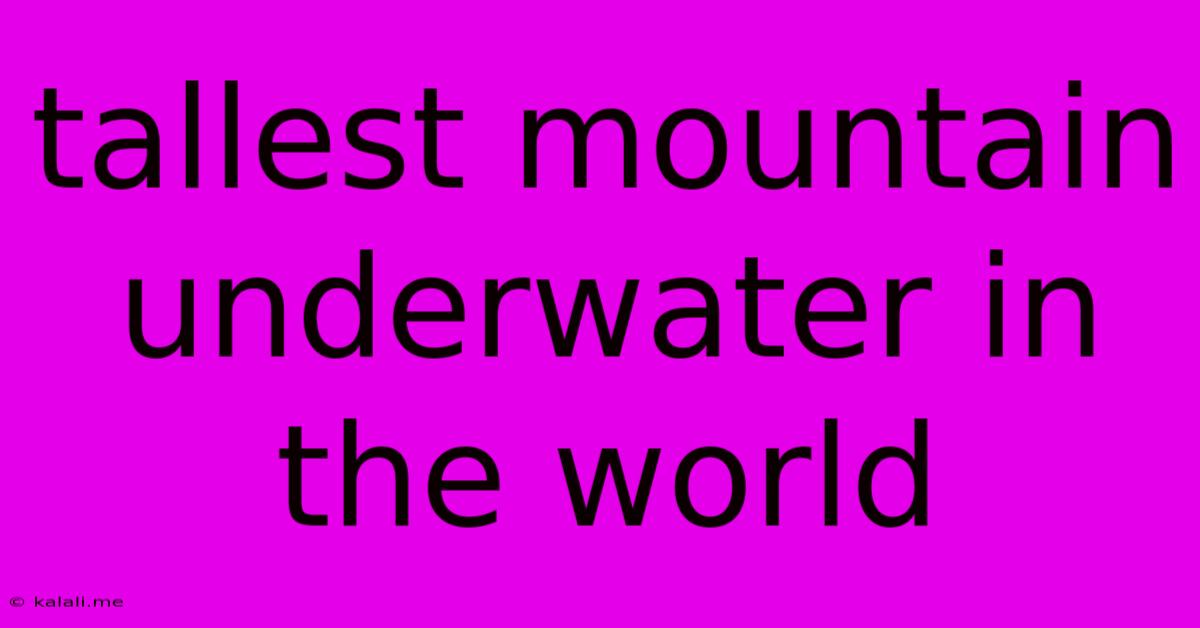Tallest Mountain Underwater In The World
Kalali
Jun 05, 2025 · 3 min read

Table of Contents
The World's Tallest Underwater Mountain: Mauna Kea's Hidden Majesty
The world's tallest mountain isn't Everest, at least not if you consider its entire height. While Mount Everest boasts the highest peak above sea level, Mauna Kea, a dormant volcano in Hawai'i, claims the title of the tallest mountain from base to summit. This colossal mountain dwarfs Everest when its submerged base is taken into account, a fact often overlooked in discussions about the world's highest peaks. This article delves into the remarkable features and geological significance of Mauna Kea, exploring why it deserves the title of the world's tallest mountain.
Mauna Kea: A Giant Beneath the Waves
Mauna Kea, meaning "white mountain" in Hawaiian, is a majestic shield volcano that rises almost 33,500 feet (10,210 meters) from its base on the ocean floor to its summit. This measurement significantly surpasses Everest's 29,032 feet (8,849 meters) above sea level. The majority of Mauna Kea, however, lies hidden beneath the Pacific Ocean, a testament to the immense scale of this underwater giant. Its immense size is a consequence of millions of years of volcanic activity, building layer upon layer of lava flows.
Geological Formation and Significance
The formation of Mauna Kea, and the other Hawaiian volcanoes, is a fascinating example of plate tectonics. The Hawaiian Islands are located on the Pacific Plate, which is moving slowly over a hotspot in the Earth's mantle. This hotspot is a plume of molten rock that rises from deep within the Earth, feeding the volcanoes and creating new land. As the plate moves, new volcanoes are formed, creating the unique chain of islands that makes up the Hawaiian archipelago. The study of Mauna Kea offers invaluable insights into volcanic processes, plate tectonics, and the Earth's geological history. Understanding its formation helps scientists better predict volcanic activity and assess potential hazards.
Ecological Importance of Mauna Kea
Despite its harsh, high-altitude environment, Mauna Kea supports a unique and fragile ecosystem. The summit region boasts specialized flora and fauna adapted to extreme conditions, including high winds, intense sunlight, and low temperatures. This unique ecosystem is also of significant cultural importance to the Native Hawaiians, who consider Mauna Kea a sacred site. The mountain’s summit is also home to several world-class astronomical observatories, taking advantage of its high altitude and clear skies for optimal stargazing. The balance between scientific research, cultural preservation, and environmental protection is a crucial aspect of Mauna Kea’s ongoing story.
Beyond the Numbers: Understanding the "Tallest" Title
The debate surrounding the "tallest mountain" title highlights the importance of defining our measurement criteria. While Everest reigns supreme in terms of elevation above sea level, Mauna Kea's total height from base to summit underscores the impressive scale of submarine geological formations. Both mountains, in their own right, are remarkable geological wonders and testaments to the powerful forces that shape our planet. Understanding these different perspectives helps appreciate the diversity and complexity of Earth's geography.
Ultimately, the title of the world's tallest mountain depends on how we define "tallest." However, Mauna Kea's sheer size and its significant geological and ecological importance undeniably solidify its place as a colossal natural wonder, deserving recognition for its unparalleled scale.
Latest Posts
Latest Posts
-
What Causes Electrical Tool To Start Just By Pluging In
Jun 06, 2025
-
Is Ac Or Dc More Dangerous
Jun 06, 2025
-
Can You Put Wall Tile On Sheetrock
Jun 06, 2025
-
What Happens If You Put A Lighter Near A Spraycan
Jun 06, 2025
-
How To Fdraw A Parabloca Between Two Points Godt
Jun 06, 2025
Related Post
Thank you for visiting our website which covers about Tallest Mountain Underwater In The World . We hope the information provided has been useful to you. Feel free to contact us if you have any questions or need further assistance. See you next time and don't miss to bookmark.